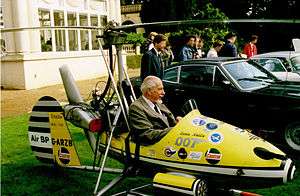Wallis WA-116 Agile
| WA-116 Agile | |
|---|---|
 | |
| Little Nellie, pictured with its creator Ken Wallis in the cockpit. | |
| Role | Single-seat autogyro |
| National origin | United Kingdom |
| Manufacturer | Wallis Autogyros Limited |
| Designer | Ken Wallis |
| First flight | 2 August 1961 |
| Number built | 10+ |
|
| |
The Wallis WA-116 Agile is a British autogyro developed in the early 1960s by former Royal Air Force Wing Commander Ken Wallis. The aircraft was produced in a number of variants, one of which, nicknamed Little Nellie, was flown in the 1967 James Bond film You Only Live Twice.
Design and development
Wing Commander Ken Wallis, a former RAF pilot, developed a number of improvements to the autogyro design, including the offset gimbal rotor head which gives the autogyro hands-off stability.[1] Wallis' first prototype autogyro, registered G-ARRT, was first flown on 2 August 1961.[2]
Operational history
In 1962, five WA-116s were built by Beagle Aircraft at Shoreham, three of which were for evaluation by the British Army Air Corps.[2] In 1966, one of the Beagle-built WA-116s, registered G-ARZB, was modified for use in the James Bond film You Only Live Twice.[3] Little Nellie was named after Nellie Wallace.[4] Few Wallis autogyros have been operated privately, with nearly all of them being used for research and demonstration flying by Wallis himself.[3]
Operators
Variants
- WA-116 Agile
- Prototype autogyro powered by a Wallis-McCulloch 4318A engine.[2]
- WA-116-T
- Two-seat variant, one built.[2]
- WA-117 Venom
- Variant powered by a 100 hp (75 kW) Rolls-Royce Continental O-200-B engine.[2]
- WA-118 Meteorite
- Variant powered by a 120 hp (89 kW) Wallis-modified Meteor Alfa supercharged two-stroke engine.[5]
- WA-119
- Variant powered by a 40 hp water-cooled 990 cc Hillman Imp engine.[2]
- WA-121
- Streamlined variant for high-altitude research with a Wallis-McCulloch engine; a single WA-121 was built in 1972.[2]
Specifications (WA-116)
Data from [2]British Civil Aircraft since 1919 – Volume 3
General characteristics
- Crew: 1
- Length: 3.38 m (11 ft)
- Rotor diameter: 6.20 m (20 ft 4 in)
- Height: ()
- Empty weight: 116 kg (255 lb)
- Loaded weight: 249 kg (550 lb)
- Powerplant: 1 × Wallis-McCulloch 4318A piston engine, 54 KW (72 hp)
Performance
- Maximum speed: 161 kmh (100 mph[6])
- Range: 209 km (130 miles)
- Endurance: 2 hr 27 min
- Service ceiling: 10,000 ft[6] ()
- Rate of climb: 1,000 ft in 56 sec[7] ()
58 lb fuel, power/wt 7.651b/hp[8]
See also
References
Notes
- ↑ "The Wallis Autogyros." Flight. 31 March 1966. p. 515.
- 1 2 3 4 5 6 7 8 Jackson (1974). p. 329.
- 1 2 Apostolo (1984). p. 101.
- ↑ Places & Faces, "The Name's Wallis" (accessed 2013-12-12)
- ↑ https://www.flightglobal.com/FlightPDFArchive/1966/1966%20-%201560.PDF
- 1 2 "The Wallis Autogyros." Flight. 31 March 1966. p. 520.
- ↑ "The Wallis Autogyros." Flight. 31 March 1966. p. 518.
- ↑ "The Wallis Autogyros." Flight. 31 March 1966. p. 517.
Bibliography
- Apostolo, Giorgio (1984). The Illustrated Encyclopedia of Helicopters. New York: Bonanza Books. ISBN 0-517-439352.
- Jackson, A.J. (1974). British Civil Aircraft since 1919 – Volume 3. London: Putnam & Company Ltd. ISBN 0-370-10014-X.